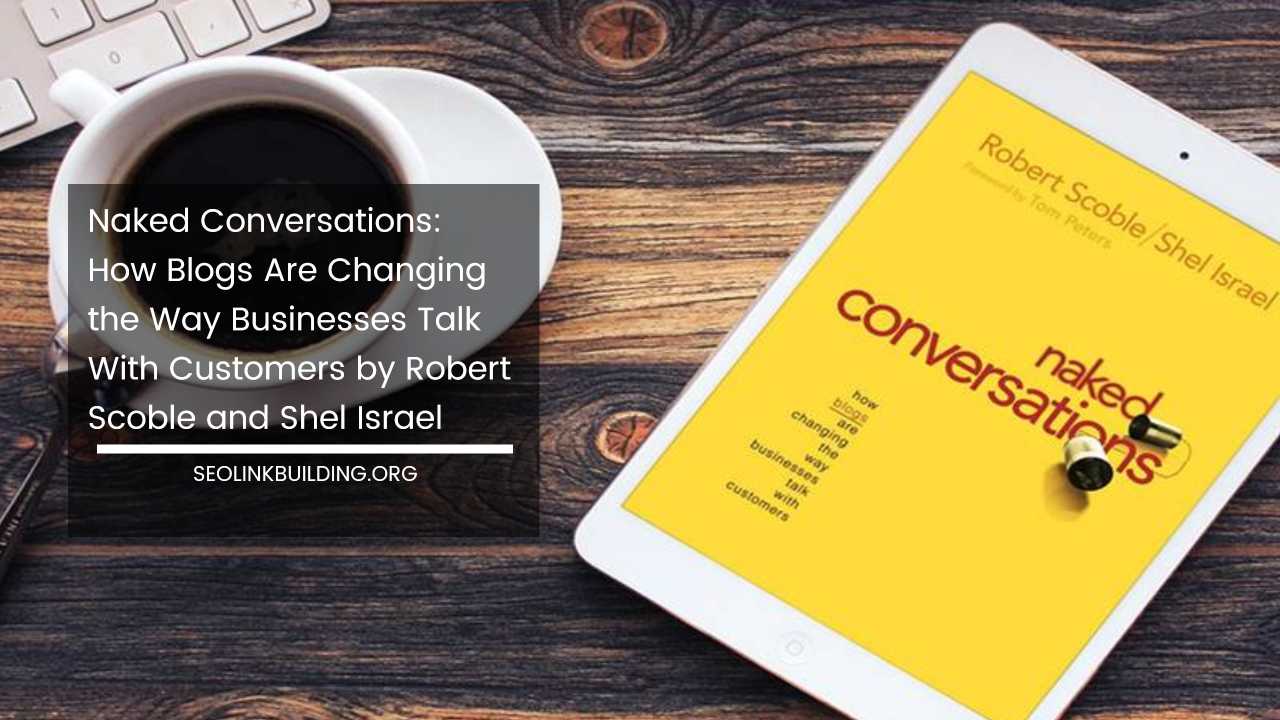Naked Conversations: How Blogs Are Changing the Way Businesses Talk With Customers By Robert Scoble and Shel Israel

From Monologue to Dialogue: How Blogs Revolutionized Business Communication (and What Lies Ahead)
In the pre-internet era, business communication resembled a megaphone aimed at a faceless crowd. Companies broadcasted press releases and marketing materials, often couched in jargon, hoping they’d resonate with a passive audience. But the rise of the web, and particularly the advent of blogs, fundamentally altered this dynamic.
Robert Scoble and Shel Israel’s book, Naked Conversations: How Blogs Are Changing the Way Businesses Talk With Customers, published in 2006, captured this pivotal shift.
The Power of Unfiltered Communication and the Birth of the Blogosphere
Scoble, a veteran tech blogger himself, and Israel, a business consultant, championed the concept of “naked conversations” in the burgeoning blogosphere. Unlike traditional marketing materials, blogs offered a platform for authentic, unfiltered communication.
Businesses could shed the corporate veil and engage in genuine dialogue with their audience. This transparency fostered trust and a sense of community, where customers felt valued and heard.
Beyond Buzzwords: The Tangible Benefits of Business Blogging
The book highlights the numerous benefits of embracing blogs for businesses, which extend far beyond a fleeting trend:
- Humanizing the Brand: Blogs allowed companies to showcase their human side. Employees with diverse perspectives could share their expertise and insights, creating a more relatable brand image. Imagine a software company’s blog featuring posts from engineers discussing product development challenges or designers explaining the creative process behind a new interface. This fosters a connection that dry press releases simply cannot achieve.
- Improved Customer Service: Businesses could address customer concerns directly through blog comments and discussions. This fostered a sense of responsiveness and problem-solving that traditional channels, like email ticketing systems, often lacked. A frustrated customer encountering a technical issue can find resolution and support through a blog post outlining troubleshooting steps, followed by comments from other users sharing their experiences and potential solutions.
- Building Relationships: Blogs facilitated ongoing conversations with customers. Businesses could share industry knowledge, answer questions in real-time, and solicit feedback, fostering stronger and more loyal customer relationships. A clothing company, for instance, could use their blog to showcase new styles, host Q&A sessions with designers, and encourage customer feedback on upcoming collections. This interactive approach builds trust and loyalty, turning customers into brand advocates.
- Market Research in Action: By analyzing blog comments and discussions, businesses gained valuable insights into customer needs, preferences, and pain points. This real-time feedback informed product development, marketing strategies, and overall customer experience. Imagine a fitness tracker company analyzing blog comments to identify user frustrations with battery life or connectivity issues. This data can then be used to improve future product iterations.
The Art of “Naked Conversations”: A Practical Guide
Scoble and Israel don’t merely advocate for blogging; they provide a roadmap for success. They emphasize the importance of authenticity, urging businesses to avoid canned marketing speak and embrace a conversational tone. Here, the book delves into actionable steps for businesses to navigate the blogosphere:
- Developing a Winning Blogging Strategy: Defining goals, identifying target audiences, and choosing the right blogging platform are crucial first steps. A travel agency might aim to create a blog that inspires wanderlust and provides travel tips, targeting young professionals seeking adventure vacations. The platform they choose should be user-friendly and integrate seamlessly with their existing website.
- Creating Compelling Content: Blogs should offer valuable information, insights, and entertainment, not just self-serving sales pitches. Regular updates and diverse content formats like listicles (“Top 10 Packing Tips for Budget Travel”), interviews with travel bloggers, and case studies (“From Couch Potato to Marathon Runner: My Fitness Journey”) keep readers engaged and coming back for more.
- Building a Community: Encourage comments, discussions, and guest posts from industry experts to foster a sense of community around your blog. Actively engage with readers, respond to comments promptly, and address concerns in a transparent and helpful manner. Imagine a lively discussion unfolding in the comments section of a blog post about sustainable travel practices, where readers share eco-friendly travel tips and companies showcase their commitment to responsible tourism.
- Integrating Blogs with Other Channels: Promote your blog on social media, email marketing campaigns, and other communication channels to reach a wider audience. Track blog analytics to measure success and identify areas for improvement. Analyze data on website traffic, user engagement, and social media shares to understand what resonates with your audience and refine your content strategy accordingly.
Beyond the Blog: The Evolving Landscape of Customer Engagement
While the book focuses on the early days of blogging, the core principles outlined in Naked Conversations remain relevant in today’s dynamic digital landscape.
While platforms like social media have become dominant forces, the essence of fostering open communication and building relationships with customers holds true.
Here’s how the book’s ideas translate to the current digital landscape:
- The Rise of Social Media: Social media platforms like Twitter, Facebook, and Instagram have become powerful tools for businesses to connect with customers in real-time. Engaging in conversations, responding to comments, and hosting live Q&A sessions mirror the principles of “naked conversations” in a more interactive format. Imagine a customer tweeting their frustration with a delayed delivery. The company can respond directly on Twitter, offering apologies, providing tracking information, and outlining steps to resolve the issue. This transparency and responsiveness build trust and demonstrate a commitment to customer satisfaction.
- The Power of User-Generated Content: Businesses can leverage customer reviews, testimonials, and social media posts to showcase their brand authenticity and build trust with potential customers. A restaurant can share positive customer reviews on their website and social media channels, highlighting the delicious food and exceptional service. User-generated content, when curated effectively, adds a layer of credibility that traditional marketing materials often lack.
- Content Marketing as a Conversation Starter: Creating valuable content like blog posts, infographics, and videos establishes businesses as thought leaders and attracts potential customers. Educational content, such as “how-to” guides and explainer videos, positions businesses as experts in their field and fosters trust with potential customers. Imagine a financial services company creating blog posts on budgeting tips or investment strategies. This informative content attracts potential customers seeking financial guidance and positions the company as a reliable resource.
The Enduring Impact of “Naked Conversations”: Lessons Learned for the Future
Naked Conversations serves as a reminder that successful communication goes beyond simply delivering messages. It’s about fostering genuine connections, building trust, and creating a community around your brand. Here are some key takeaways that remain relevant in today’s digital age:
- Prioritize Authenticity: Customers crave genuine interactions. Avoid robotic marketing speak and embrace a conversational tone. Speak directly to your audience’s needs and concerns.
- Be Transparent: Acknowledge mistakes and address customer concerns promptly and openly. Transparency builds trust and demonstrates a commitment to customer satisfaction.
- Embrace Two-Way Communication: Encourage conversations, answer questions, and actively participate in discussions. Listen to your audience and use their feedback to improve your products, services, and overall customer experience.
- Become a Thought Leader: Share valuable industry insights and educational content that positions your brand as an authority in its field. Attract customers by providing solutions to their problems and demonstrating your expertise.
- Measure and Adapt: Track your communication efforts and analyze customer engagement data. Use this information to refine your strategies and ensure your messages are resonating with your audience.
The Future of Customer Engagement: What Lies Ahead?
While blogs remain a valuable tool, the communication landscape continues to evolve. Here are some emerging trends that businesses should consider:
- The Rise of Conversational Interfaces: Chatbots and voice assistants powered by artificial intelligence (AI) offer new avenues for customer engagement. Businesses can leverage these technologies to provide real-time support, answer frequently asked questions, and personalize the customer journey. Imagine a customer using a voice assistant to effortlessly schedule a service appointment or track an order.
- The Power of Influencer Marketing: Partnering with relevant social media influencers can extend your brand reach and connect with new audiences. Influencers who resonate with your target market can promote your products or services in a more organic and authentic way.
- The Immersive Future: Technologies like augmented reality (AR) and virtual reality (VR) have the potential to revolutionize customer engagement. Imagine a furniture company allowing customers to use AR to virtually place furniture pieces in their homes before making a purchase.
The Last Word: A Continuous Conversation
The digital age presents a dynamic landscape for customer engagement. By embracing the core principles of “naked conversations” – authenticity, transparency, and two-way communication – businesses can build lasting relationships with their customers.
As technology continues to evolve, businesses must remain adaptable and explore new avenues for meaningful customer interactions. The future of customer engagement lies not in a one-way monologue, but in an ongoing conversation where businesses and customers connect, learn from each other, and build trust together.













